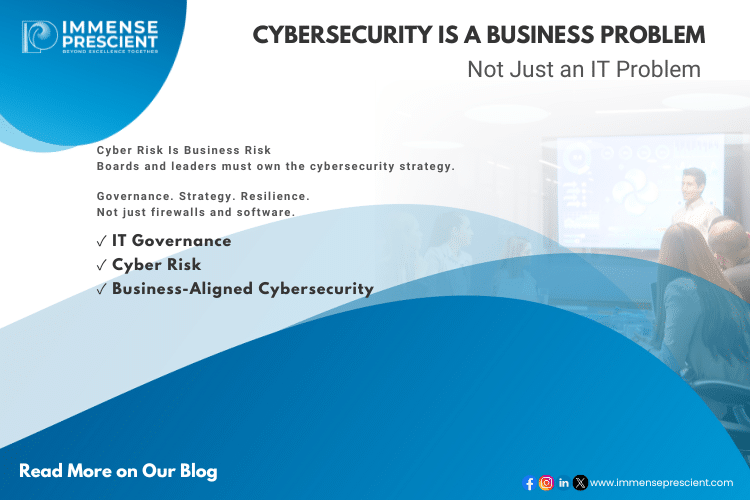Cybersecurity Is a Business Problem, Not Just an IT Problem
Introduction – Cybersecurity is a business problem
In today’s hyper-connected economy, cybersecurity breaches are no longer isolated IT events they’re existential business risks. Boards, CEOs, and business unit leaders need to understand that cybersecurity is a business problem, not just a technical one.
Why Cybersecurity Is a Business Problem
Cyberattacks can disrupt supply chains, erode customer trust, and destroy shareholder value. The consequences regulatory fines, reputational damage, and loss of intellectual property impact every corner of the business. Leaders can no longer afford to silo security under IT.
Related Reading: Digital Trust Will Define the Next Decade of Business
Key takeaway: Cybersecurity belongs on the executive agenda, not only the CIO’s.
Cyber Risk = Business Risk
- Financial Impact: Data breaches can cost millions in regulatory penalties and legal settlements.
- Brand Reputation: Trust, once broken, is hard to regain.
- Operational Disruption: Ransomware or phishing attacks can halt critical services.
A strong cybersecurity program should be treated like a core component of enterprise risk management. For best practices, frameworks like the NIST Cybersecurity Framework can help organizations assess and improve their cyber maturity.
Leadership’s Role in Cybersecurity
Business leaders must:
- Integrate cybersecurity into strategic planning.
- Allocate budgets based on business risk, not IT spend.
- Promote a culture of security awareness.
- Establish board-level oversight on cyber readiness.
See also: How AI Can Help Leaders Make Smarter, Faster Decisions using AI effectively can also improve your cyber defence posture.
How to Make Cybersecurity Everyone’s Responsibility
- Cross-Functional Teams: Include security leaders in business unit planning.
- Employee Training: Security awareness campaigns reduce human error.
- Third-Party Risk Management: Vet partners and vendors carefully.
- Incident Response Playbooks: Test scenarios across departments.
According to the World Economic Forum, global cybercrime costs could reach trillions annually, making cross-functional collaboration essential.
Building a Resilient Cybersecurity Strategy
The best organizations bake resilience into their operations. Regular penetration testing, zero-trust architecture, and continuous monitoring all strengthen defence and recovery. But equally important is leadership buy-in and clear communication.
Frameworks like NIST Cybersecurity Framework and insights from the World Economic Forum provide clear benchmarks for resilience and readiness.
Conclusion
Cybersecurity is no longer just about firewalls and encryption — it’s about safeguarding your brand, operations, and future. Treating cybersecurity as a business problem enables better decision-making, stronger risk management, and a foundation of trust with customers and stakeholders.




